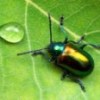Compare:

Lasius claviger at f/3.5

Lasius claviger at f/13
I wouldn't say that either image is better. The first is dreamier, more abstract, more interpretive. The second is crisp and illustrative. Quite a difference for a small tweaking of camera settings!
Most of my insect photography falls in the small-aperture realm of the second image, but on reflection I probably ought to play around more with images like the first one.
More like this
Lasius claviger citronella ants

I agree. Both are great, different intentions.
I really like the shallow depth of field of the first one, and how it isolates the heads in the foreground. But I didn't realize the white mass in the middle were eggs until I saw the second, all in focus, image. The latter probably better for that illustrated textbook on ants you are writing (wink wink).
I think both images are beautiful for very different reasons. The limited DOF in the first image has an otherworldly feel to it, a very finite reality with the rest of the infinite universe blurred away as background noise. The second brings it all into clear view and answers the question of what precisely is going on. For artistic points, the first one wins hands down; for technical points, the second definitely takes the cake.
As an ever-more presbyopic (far-sightedness related to age) individual, I relish the deep clarity of the second image.